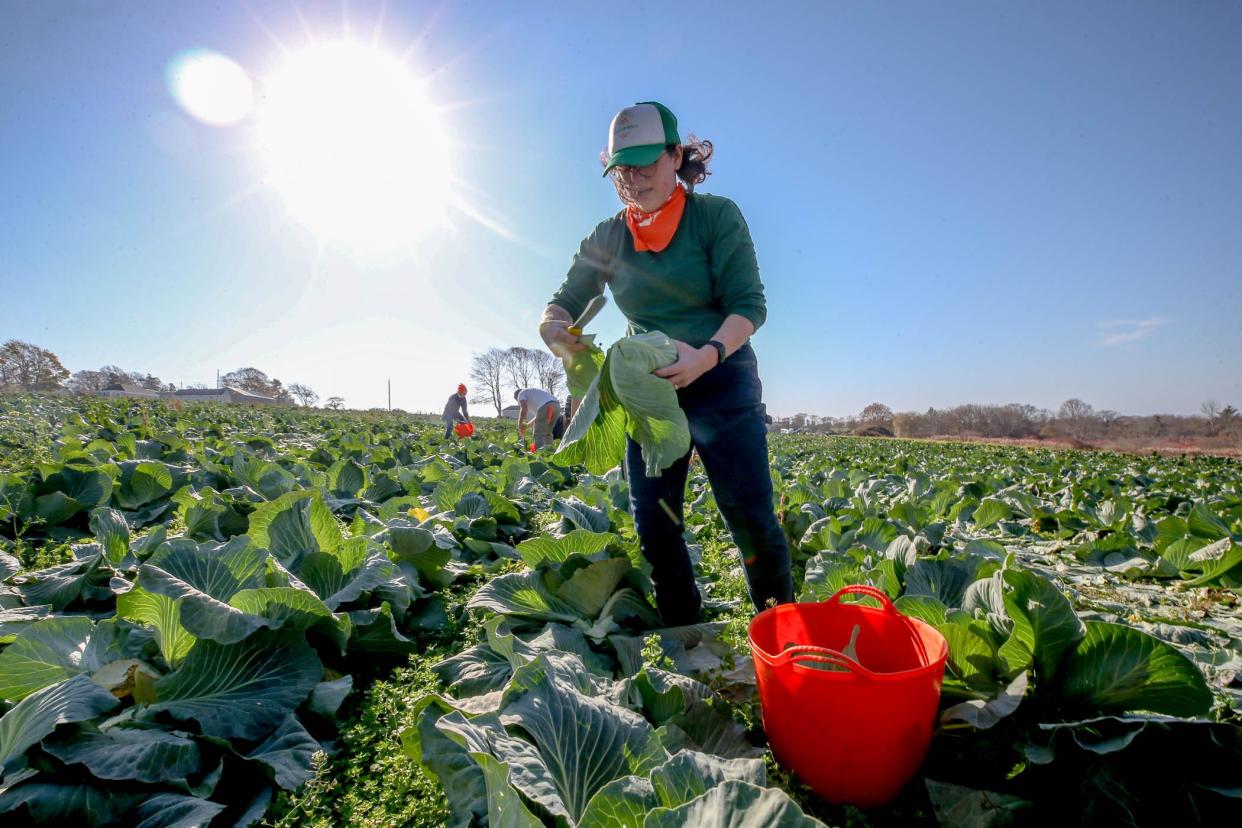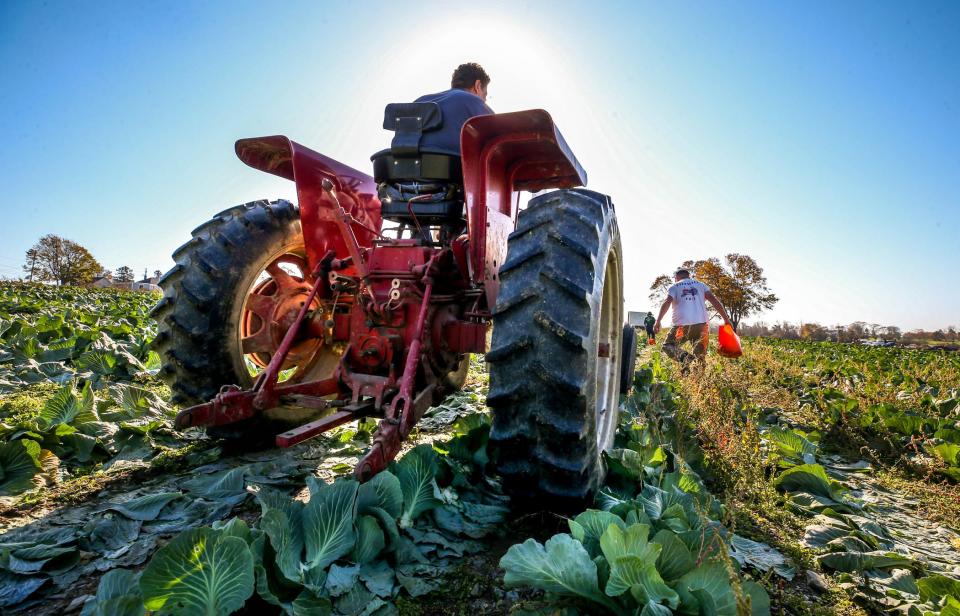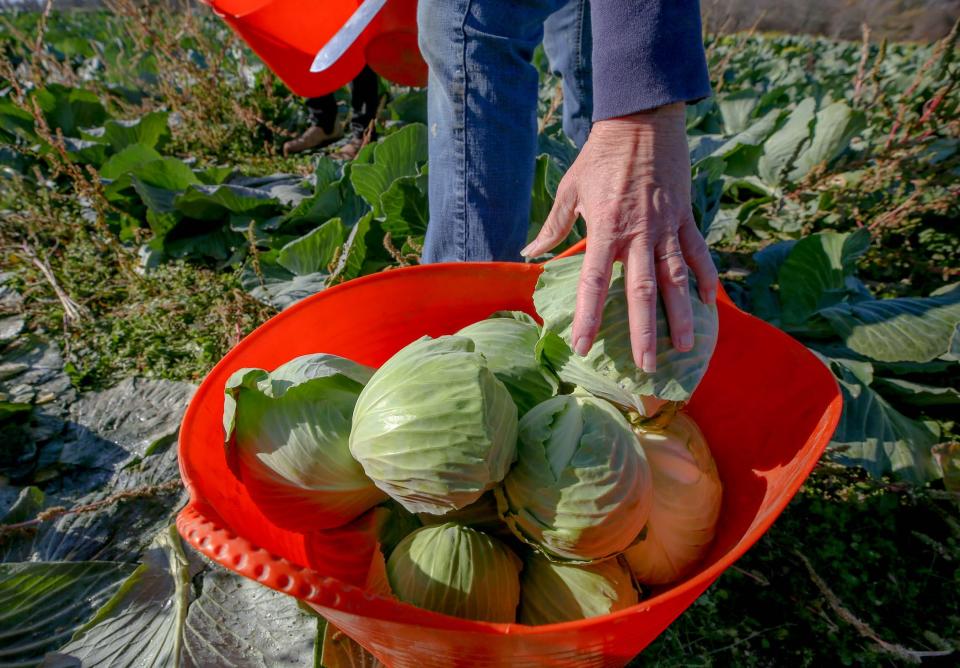Ugly veggies? Hope's Harvest bridges gap between farmers and food pantries

PORTSMOUTH — The view of Narragansett Bay from the crest of Aquidneck Island was stunning, but Eva Agudelo was more interested in the ground beneath her feet.
Searching for stray cabbages in one of the fields at DeCastro Farms, she picked her way through the dirt, stopping every few steps to bend down, slice through a stalk and retrieve a leafy green head. Agudelo worked with a practiced hand, as did the two volunteers who labored alongside her on a brilliantly sunny morning. In less than two hours, they harvested about 1,300 pounds of cabbage.
None of it was destined for sale. Instead, Agudelo, executive director of Hope’s Harvest RI, made sure it was all donated to feed the hungry.
Founded three years ago by Agudelo, her Providence-based nonprofit occupies a unique niche in Rhode Island’s food system, collecting unharvested fruits and vegetables that would otherwise go to waste and distributing them to food pantries and other organizations that help the poor.
With Thanksgiving here and Christmas just around the corner, this is typically a busy time of year for Hope’s Harvest as it gathers up everything from apples to kale to butternut squash for holiday meals.
But it’s even busier this year because of the unseasonably warm weather. There hasn’t been a hard frost yet, so farmers are still able to harvest their crops. And that means Agudelo and her team are still hard at work gathering up whatever is left behind.
Farmer Stephen DeCastro came through this field off Middle Road the day before and took all the cabbages he could sell. But it’s not worth his time to harvest the ones that remain. Most are too small for grocery stores. Others are misshapen.

If Agudelo hadn’t called him, DeCastro would have plowed the vegetables under to enrich the soil and ready the field for next year's planting of corn.
“If it’s a little small or a little big, people complain. There’s nothing wrong with the cabbage that we’re cutting today. They’re just undersized for the consumer market,” DeCastro said from the seat of his tractor. “These days, nobody wants it unless it’s absolutely perfect.”
“I want it!” Agudelo practically shouted as she tossed cabbages into a bin.
Getting produce to the hungry
Their exchange neatly encapsulates what Hope’s Harvest is all about. An extraordinary amount of fruits and vegetables goes unharvested — billions of tons a year nationwide — because they may not look right, they may be surplus to what a farmer can sell or they’re too labor-intensive to collect.
“The farmers aren’t doing anything wrong,” Agudelo said. “People think of it like a factory — you make as many widgets as you have customers for. But the natural world is nothing like a widget factory.”
That’s why Hope’s Harvest stepped in. While there are longstanding operations in other states to ensure produce isn’t wasted, before Agudelo started her organization three years ago, there was nothing like it in Rhode Island.

The Rhode Island Community Food Bank used to organize trips to farms from time to time, and smaller food pantries would sometimes do the same. But those excursions didn’t happen often and groups were limited in how much they could take.
A former program director at the food bank who holds a master’s degree in nutrition science from Tufts University, Agudelo had spent years working with farmers and knew what was available if it could just be collected.
'It wasn't anybody's job to do this. And it has to be.'
“The farmer’s job is to farm. The food pantry’s job is to give out food. It wasn’t anybody’s job to do this. And it has to be,” she said.
The specific word for what her organization does is gleaning. The term itself goes back to the 14th century, but the practice of farmers allowing people onto their land to gather what remains after the harvest is ancient.
Hope’s Harvest has a single overarching goal: to make sure produce that would otherwise go unpicked gets to those in need.
But by doing that, the organization fulfills several other aims. Clearly, it reduces the amount of food that goes to waste. But it also addresses an issue of social inequality by ensuring that people who depend on monthly or weekly supplies from a food pantry are getting the freshest produce, which will stay good longer.
Hope’s Harvest strengthens the local food system by making it less dependent on imports from other states. It cuts down on greenhouse-gas emissions associated with trucking food long distances.
And, though the organization gets much of the produce it collects for free, it has started paying for a good deal of food, not only buying surplus goods but also contracting with farms to grow crops.
That’s money that goes directly to farmers, which helps keep them in business. It’s no small thing in a state that has the most expensive farmland in the nation, where the incentive to sell can be significant.
In its first year of operation, Hope’s Harvest collected 36,000 pounds of food. That number grew to 274,000 pounds last year.
Volunteers harvest crops
Agudelo started Hope’s Harvest by herself, but she’s no longer alone. The organization has another full-time employee, and a staff position is filled on a rotating basis by an Americorps member. During the busiest months of late spring and summer, Agudelo also brings on paid harvesters.
But the endeavor is in large part dependent on the organization’s team of volunteers, some of whom will show up a few days a year and others who treat their work almost as part-time employment, coming out three times a week or more.
Donna Matthews, a volunteer at the Portsmouth Community Food Bank, falls into the former group so far. She’s participated in a handful of gleanings, but she also picks up deliveries from the Hope’s Harvest operations center in Providence once a week. If not for the fresh fruits and vegetables, the food bank would be buying canned goods.
“I know our clients are grateful for the fresh produce,” Matthews said. “This is a tremendous help.”
It may seem a difficult task to attract volunteers for what can be dirty, difficult work. Who really wants to spend an August day picking corn under an unrelenting sun for no pay when they could be napping on a beach instead? A lot of people, it turns out.
Agudelo had no trouble persuading people to lend a hand. She’d set up a table in farmers markets and talk to passersby.
“I’d say, ‘Do you want to volunteer on farms to feed the hungry?’” she said. “And some people would keep walking and for others, I’d see it immediately, and they’d go, ‘Yeah, yeah, I do.’”
Her powers of persuasion were evident at DeCastro Farms when she handed a knife and bucket to a reporter and had him searching for heads of cabbage alongside Matthews and fellow volunteer Bob Green.
Hope’s Harvest now has a core group of about 25 volunteers who come out regularly. Their numbers swelled at the height of the pandemic last year when, for some people, gathering produce outside became attractive as a safe form of social interaction.
“Our trips were filling up within two hours of me posting them,” Agudelo said.
'We do the work'
DeCastro and his two brothers run a farmstand on East Main Road, which they supply from the 99 acres they own and another 40 acres they lease. Now 65 years old, DeCastro’s been farming his whole life.
“When we bought our first tractor, my father put me on it to see if I could reach the pedals,” he laughs.
The family grows sweet corn, green beans, peppers, tomatoes — anything that can be sold at the stand. They also supply wholesalers in Providence and Boston. As for the less-than-perfect produce, what DeCastro describes as “the seconds,” his family eats what they can, but the rest would otherwise stay in the fields.
“It would have gone to waste,” he said. “So I’m just glad to help.”
He lifted the full bin of cabbages into the Hope’s Harvest box truck. The vegetables were destined for the Elisha Project, an East Providence nonprofit that prepares meals for the poor.
“It’s been good working with you this year, Steve. I appreciate it,” Agudelo told DeCastro.
“We didn’t do a whole lot,” he said.
“That’s the whole idea,” Agudelo said. “We do the work.”
This article originally appeared on The Providence Journal: Hope's Harvest in RI makes use of unharvested fruits and vegetables

